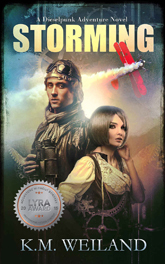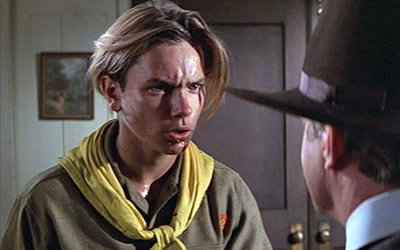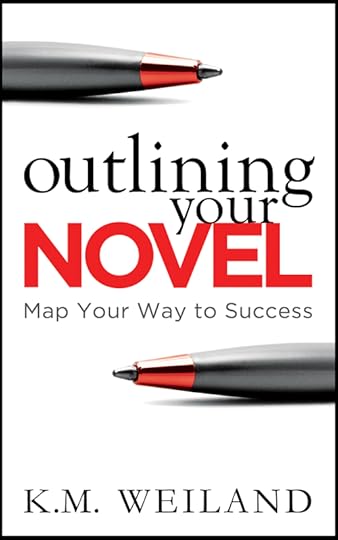4 Ways to Write Backstory That Matters (How to Outline for NaNoWriMo, Pt. 5)
 There are two equally vital parts to any story: the part you see and the part you don’t. The context and subtext. The story and the backstory.
There are two equally vital parts to any story: the part you see and the part you don’t. The context and subtext. The story and the backstory.
Whether you’re trying to figure out how to outline for NaNoWriMo (only one day away!) or just needing a game plan for your next work-in-progress, one of the most important considerations will always be backstory.
Backstory isn’t always something we consider when talking about novel outlines. It’s not, strictly speaking, part of the story. It’s just stuff that happened in the character’s past. It’ll show up naturally when the time is right. No need to explore it before you start writing, in the same way you do the main plot.
Right?
Well, that’s not necessarily wrong, but it is a mindset that can lead to a lot of missed opportunities.
Backstory will influence everything that happens in your main story—from the plot events to the characters’ motivations to your ability to manage your thematic subtext.
In short, it’s important. That being so, it’s definitely something to consider in your outline.
4 Ways to Discover Backstory That Actually Matters to Your Plot
It’s the story before the story. It’s everything that happened in your character’s past. It might even include his parents’ pasts, insofar as they have impacted the character himself, his childhood, his choices, and the life that has made him who he is when readers discover him in the Normal World of your story’s First Act.
Everything that has ever happened to your character will influence the person he is. But does that mean every little bit of is important? Every childhood baseball game, every zit in high school, every job interview?
This is an easy pitfall to fall into. You’re supposed to discover your character’s backstory, so you sit down and start writing about all the stuff that happened to him. But, frankly, most of that = snore.
The only backstory that matters is the backstory that influences the main story.
If your character suffered a brain injury after being hit in the head with a baseball, then his childhood games are important to his backstory. But if he just liked baseball? Nope, probably not going to be important enough to bother outlining, much less including in your story.
So how do you decide which parts of your character’s past are important? How do you create a backstory that is not only interesting, but that actually brings depth and weight to your main story?
There are only four questions you need to ask yourself to find your story’s best possible backstory.
1. What Brought Your Character to the Beginning of Your Main Story?
First, consider your character’s physical surroundings upon his entrance into the story. What brought him here? There are two different sides to this, which may or may not both apply to your character’s situation.
What Brought Your Character Here Purposefully?
What reason does your character have for being present when the main conflict kicks off in your story’s Inciting Event? Was he aware of the coming conflict prior to its initiation with the other characters? Did he have a desire and/or goal that prompted him to want to engage with the conflict? Or perhaps he wanted to try to stop it?
Either way, if the character has a conscious reason for being present when the conflict begins, there’s always going to backstory behind that. What brought him to this point? What made him aware of what was happening?
 For Example: In my dieselpunk/historical novel Storming, the biplane-pilot protagonist Hitch Hitchcock enters the sphere of the main conflict when he returns to the Midwestern home he fled years earlier. There is important backstory both in his initial reasons for having left home (the law was after him) and his decision to finally return (he needs to win the big airshow that has come to town).
For Example: In my dieselpunk/historical novel Storming, the biplane-pilot protagonist Hitch Hitchcock enters the sphere of the main conflict when he returns to the Midwestern home he fled years earlier. There is important backstory both in his initial reasons for having left home (the law was after him) and his decision to finally return (he needs to win the big airshow that has come to town).
What Brought Your Character Here Physically?
Your character may also be an unwitting participant in the initial conflict. She’s walking along, rather clueless, just minding her own business—when, wham!, the conflict sticks out its foot and trips her. But she had to have a reason to physically be in this particular space. Why is she here? What (seemingly?) unrelated goal is she pursuing that serendipitously leads her to this particular place at this particular time?
If you’re allowed one major coincidence in your story, this is it. Still, it’s best if you can come up with solid cause-and-effect for why your character just happens to be in the wrong place at the wrong time (or perhaps it’s the right place at the right time?).
For Example: In Storming, Hitch first brushes the main conflict in the Hook in the first chapter when two people fall out of the clear night sky right in front of his biplane. The immediate backstory answers the question of why he happens to be out there flying around in the dark (testing a modification on his plane), as well as why these two falling people are out there (SPOILER!).
2. What Is Your Character’s Motivation?
Arguably, the most important discovery you can make in outlining your backstory is that of your character’s motivation. What does he want in the plot? What is the Thing He Wants from life? And what related goal is powering him through the main plot?
And, most importantly of all, why does he want it?
Think of backstory as the cause to your main story’s effect. If the main story is the what, the backstory is the why.
This is a crucial pairing. It is was creates the illusion of realism within your story world. Without this all-important motivation in your character’s backstory, the verisimilitude of the story falls apart. In real life, people never pursue things without reasons. We get up to get a drink of water because we’re thirsty. We buy someone a gift because we love them. We rob banks because we’re poor… or greedy… or adrenaline junkies. There’s always a reason.
In stories, character motivation can manifest in one of two ways:
Motivation From Within the Story Itself
Sometimes, your character’s motivation will arise from within the story itself. He becomes paralyzed at the First Plot Point, which initiates a motivation and a goal he never had to even think about prior to this event: learn to walk again.
But even in these instances, it’s best if the character’s new goal is grounded in a deeper reason within his past life. Indiana Jones has no goal or motive to pursue the Ark of the Covenant until he learns of its existence, but his reasons for being in a position to go after it—the reason he is an archaeologist/adventurer—are deeply rooted in his existing life and (as we discover in The Last Crusade) his childhood relationship with his father.

Indiana Jones’s motivations for becoming an archaeologist go all the way back to his childhood, as we finally discover in his backstory in The Last Crusade.
For Example: In Storming, Hitch meets one of the people who fell from the sky—the mysterious and unpredictable young woman Jael—and agrees to help her return to what she insists is her home in the sky. Prior to meeting her, this goal was nowhere on his radar, but his motivation is grounded in both his preexisting goal of winning the airshow (Jael agrees to wing walk in his act as part of the deal) and out of his own longstanding, if conflicted, relationships with people (wanting to help them, but afraid of getting tied down—which is why he left his hometown all those years ago).
Motivation From the Character’s Past
Your character’s primary motivation for pursuing the main story goal may also be deeply rooted in events that happened prior to the beginning of the book itself. Almost always, you will want the Lie the Character Believes, which is at the heart of both the character arc and the theme, to be rooted in his past life (see the next section’s question about the Ghost). But the goal itself may originate prior to the story, only to be complicated as he engages with the obstacles of the main conflict in the Inciting Event and First Plot Point.
If this is so in your story, ask yourself: Why did the character first conceive this goal? What prompted him to want it? What’s his motivation? What prompted him to transform his desire into action?
For Example: In Storming, Hitch starts the story with the existent goal of winning Col. Bonney Livingstone’s famous air competition, so he can earn enough money to start his own air circus. This is the Thing He Wants, which provides the frame for his actions throughout the entire story, even before he gains his main story goal of helping Jael.
3. What Is Your Character’s Ghost?
What creates character motivation within your story? Even more to the point, what creates a character motivation that is pertinent to your main conflict?
Look no farther than the Ghost.
The Ghost is the single most important event that has happened in your character’s life prior to the main story. In some ways, it’s even the reason the main story is happening at all. If you know nothing else about your character’s backstory, at least know the Ghost. It will influence every decision you make about your story, from character motivations to plot goals to thematic principles.
The Ghost is the wound in the character’s backstory. It is the reason he clings to the Lie He Believes. It can be something deep and dark (such as the murder of a loved one) or it can be comparatively small and normal (such as a disapproving parent). Whatever it is, it’s at the root of your character’s motivation and, by extension, the Thing He Wants and his very plot goal.
The Ghost is what ensures your backstory is not a random history attached to your character just to make him seem more “rounded.” The Ghost is integral to the main story. It is what creates your character’s subtext. Fail to understand your story’s Ghost—or, worse, fail to give your character a backstory Ghost that actually matters to the main conflict—and you will lose the all-important cause to your story’s effect.
For Example: In Storming, Hitch’s Ghost is his broken relationships with his family—his dead wife, his wounded brother, and his embittered sister-in-law. He wants his remaining family to understand why he had to leave (because a corrupt sheriff was on his tail), but he’s still hung up on his own fear that responsibility and relationships will destroy his independence.
4. Which Backstory Revelations Will Advance the Plot?
Once you’ve explored the above questions and gained a complete view of your character’s past, why she is the way she is, and what will make her react to your main conflict the way she will—your final step is to figure out how you can also use all this juicy backstory stuff to power the main plot.
At its simplest, backstory will provide only the necessary context for your character’s motivations. But you can up the ante by using the backstory itself to power the plot through discoveries and reveals.
What can your character discover about her own past that will move the conflict? What can she discover about other characters’ pasts? What can other characters discover about her past? And what can be revealed to readers at strategic moments that will pull them deeper into the story?
Write a list of all the juicy stuff you’ve discovered in your character’s backstory. Now consider: how can you use these things to create mystery and to pull readers along? Instead of simply telling readers all about the backstory upfront, how can you uncover it, bit by bit, at strategic moments throughout the story, in a way that advances the plot?
You know something advances the plot when it changes the conflict. Its revelation either allows the character to move forward in informed ways, or it throws up obstacles she must then figure out how to overcome. This is backstory’s most delicious role in any story.
For Example: In Storming, Jael’s mysterious origins are only slowly doled out throughout the story. As Hitch discovers more and more about her backstory, he is drawn deeper and deeper into the main conflict of helping her get home before her pursuers can destroy his hometown.
A Warning About Priorities: Don’t Get Too Infatuated With Your Backstory
Brainstorming backstory is always one of my favorite parts of the outline. You never know what intriguing possibilities you will discover in your characters’ pasts. Often, you will learn things you would never have guessed, and which will then take the story in exciting new directions.
But don’t get too carried away.
I receive more questions about backstory than I can count, and most of them are from authors who either
a) have more backstory than they know how to use
-or-
b) are so in love with their backstory, they’re determined to use every last bit of it, at the expense of the main story
It’s important to note backstory is not your story. It is only a tool to advance the main story. It is almost always at its most powerful when used with restraint, when it is allowed to remain largely subtextual.
Some writers end up writing pages upon pages (tens of thousands of words, even) about their backstories. Nothing wrong with that, but always remember backstory’s purpose within your story. Don’t allow yourself to become so infatuated with your characters’ pasts that you allow them to overshadow the all-important present in your main story.
When the time comes to sow your backstory into your main story, remember this rule of thumb: Only share backstory if and as it becomes necessary to either advance the main plot or allow readers to understand what’s happening.
Now have fun digging into your characters’ fascinating pasts!
Stay Tuned: Next week, we’re going to talk about how to weave all of your story pieces together into a cohesive whole.
Previously in This Series:
Should You Outline Your Novel?
Start Your Outline With These 4 Questions
3 Steps to Find the Heart of Your Story
How to Find and Fill All Your Plot Holes
Wordplayers, tell me your opinion! How will your protagonist’s backstory affect the main plot? Tell me in the comments!
http://www.podtrac.com/pts/redirect.mp3/kmweiland.com/podcast/4-ways-to-find-backstory-that-matters-nanowrimo-guide-to-outlining.mp3
Click the “Play” button to Listen to Audio Version (or subscribe to the Helping Writers Become Authors podcast in iTunes).
The post 4 Ways to Write Backstory That Matters (How to Outline for NaNoWriMo, Pt. 5) appeared first on Helping Writers Become Authors.
 newest »
newest »
 So helpful :) Thanks!
So helpful :) Thanks!





